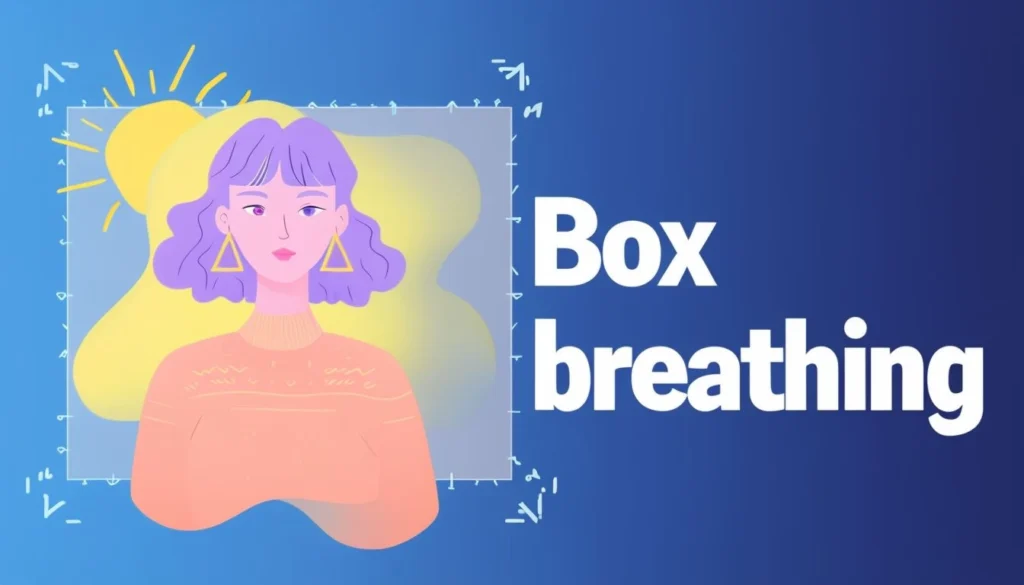
Introduction
In a world filled with endless to-do lists and constant distractions, finding effective ways to manage stress and stay focused is essential. One technique that’s gaining traction for its simplicity and effectiveness is box breathing, also known as square breathing. Used by Navy SEALs, athletes, and mindfulness practitioners alike, this controlled breathing method is a powerful tool for cultivating calm and clarity. In this guide, we’ll explore what box breathing is, how it works, its benefits, and how to seamlessly integrate it into your daily life.
What Is Box Breathing?
Box breathing is a structured breathing technique involving equal counts of inhaling, holding, exhaling, and pausing. This four-step pattern resembles a square, with each phase lasting the same amount of time. The basic steps include:
- Inhale through your nose for 4 seconds.
- Hold your breath for 4 seconds.
- Exhale through your mouth for 4 seconds.
- Pause with empty lungs for 4 seconds.
This technique can be adjusted to longer or shorter counts depending on your comfort level and goals, making it accessible to everyone.
How Does Box Breathing Work?
Box breathing works by directly engaging the parasympathetic nervous system, which counteracts the body’s stress response. Here’s a closer look at how it impacts your body and mind:
- Regulates Breathing: Controlled breathing ensures a steady oxygen flow, reducing hyperventilation and promoting relaxation.
- Balances CO2 Levels: The pause during the breath-hold helps maintain optimal carbon dioxide levels, improving blood flow and calming the nervous system.
- Enhances Focus: Focusing on the rhythmic count anchors your mind, reducing mental chatter and increasing present-moment awareness.
Benefits of Box Breathing
Box breathing offers a host of physical, mental, and emotional benefits, making it a valuable practice for anyone seeking balance in their lives.
1. Reduces Stress and Anxiety
The slow, deliberate breaths help calm the “fight-or-flight” response, lowering cortisol levels and fostering a sense of peace.
2. Improves Focus and Clarity
By anchoring your attention on your breath, box breathing minimizes distractions and enhances cognitive function.
3. Boosts Emotional Resilience
Regular practice strengthens your ability to manage stress and respond to challenges with greater composure.
4. Supports Respiratory Health
Over time, box breathing increases lung capacity and improves respiratory efficiency.
5. Enhances Sleep Quality
Practicing box breathing before bedtime can quiet the mind, preparing your body for restful, restorative sleep. Pair it with soothing scents using an essential oil diffuser.
How to Practice Box Breathing
Here’s a step-by-step guide to mastering box breathing:
- Find Your Space: Sit in a comfortable position, ensuring your back is straight and shoulders are relaxed. For added comfort, use a yoga mat or a cushion.
- Start with a Deep Exhale: Empty your lungs fully to prepare for the first inhale.
- Inhale: Slowly breathe in through your nose for 4 seconds, allowing your belly to expand.
- Hold: Retain the air in your lungs for 4 seconds. Stay relaxed during this phase.
- Exhale: Gently release the breath through your mouth for 4 seconds, making a soft “whooshing” sound.
- Pause: Hold your breath with empty lungs for 4 seconds.
- Repeat: Continue this cycle for 5-10 minutes or as needed.
When and Where to Use Box Breathing
The versatility of box breathing makes it suitable for various situations. Here’s how you can incorporate it into your day:
During Stressful Moments
Whether it’s a high-pressure meeting or an overwhelming situation, box breathing can help you regain composure and clarity.
Before Performance
Athletes, performers, and speakers often use box breathing to calm nerves and enter a focused state before important events.
As a Daily Habit
Integrate it into your morning routine to set a calm tone for the day or your evening routine to unwind.
At Work
Take short box breathing breaks during the day to recharge and improve productivity. Pair this practice with ergonomic support from a desk chair cushion for maximum comfort.
Scientific Backing for Box Breathing
Research supports the effectiveness of controlled breathing in enhancing mental and physical health:
- Reduces Stress: Studies indicate that slow, deliberate breathing lowers cortisol levels and decreases blood pressure.
- Improves HRV: Box breathing enhances heart rate variability (HRV), a marker of stress resilience and cardiovascular health.
- Enhances Cognitive Function: Rhythmic breathing has been shown to improve focus, decision-making, and emotional regulation.
Tips for Success
- Start Small: Begin with 2-5 minutes of practice and gradually extend to 10-15 minutes as you grow comfortable.
- Adjust the Counts: If 4 seconds feels too long, start with 3-second counts and increase as needed.
- Create a Relaxing Environment: Use dim lighting or calming music to enhance your experience. A Himalayan salt lamp can add a soothing ambiance.
- Combine Techniques: Pair box breathing with mindfulness or yoga for a holistic approach to well-being.
FAQs About Box Breathing
Q: How long should I practice box breathing? A: Start with 5 minutes daily and gradually increase as you feel comfortable.
Q: Can box breathing help with panic attacks? A: Yes, it’s an effective tool for calming the nervous system during panic episodes.
Q: Is box breathing suitable for everyone? A: While generally safe, individuals with respiratory conditions should consult a healthcare provider before practicing.
Final Thoughts
Box breathing is a simple yet transformative practice that can help you manage stress, enhance focus, and improve overall well-being. Its versatility and accessibility make it a valuable tool for anyone seeking greater balance in their life. Whether you’re preparing for a challenging task, seeking a moment of calm, or improving your sleep quality, box breathing offers a natural, effective solution.















